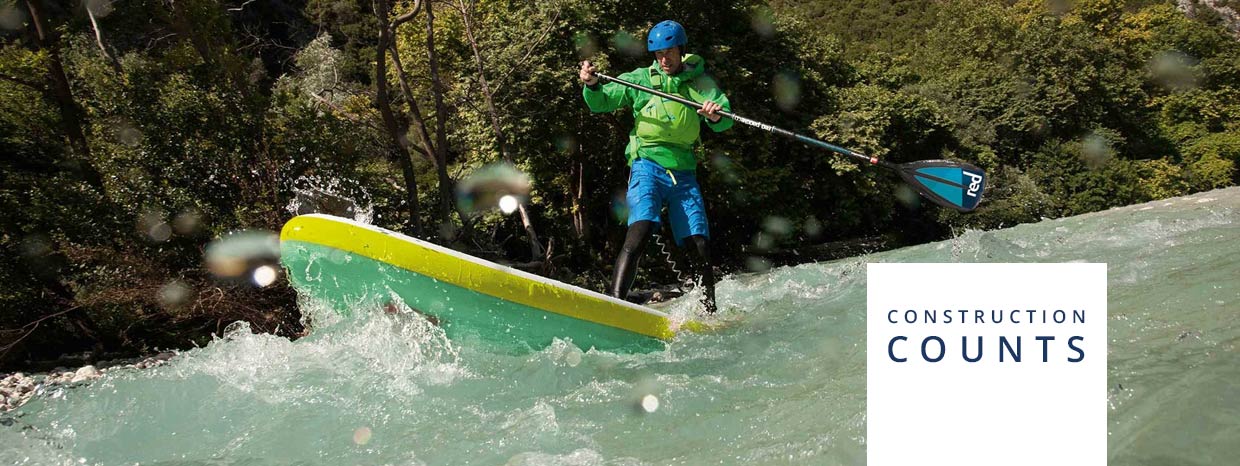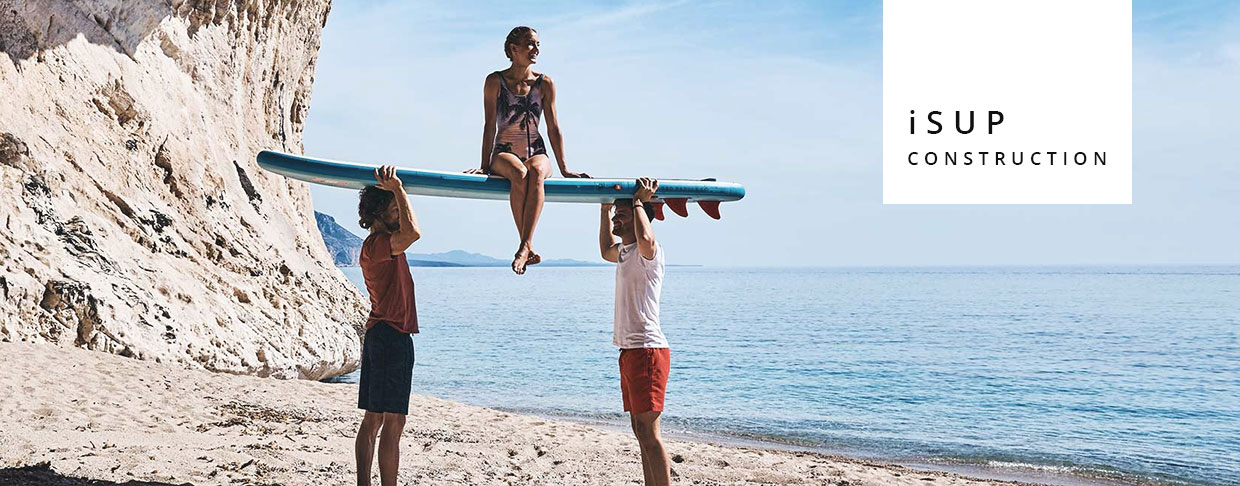
Each Inflatable SUP manufacturer offers a range of boards, and there are usually a variety of construction choices. How the paddleboard is made and the materials used have a big influence on how a board paddles, how long it may last and the price you pay. There are pros and cons for each construction, and so choosing the best SUP for you can be a little confusing. That's why we've put together this handy guide to give you the low-down on the key construction options. Each brand will have slightly different ways of doing things, but these four constructions pretty much have it covered; Single Skin, Stringer, Glued Double Layer and Laminated Double Layer and Woven.
Single Skin Construction
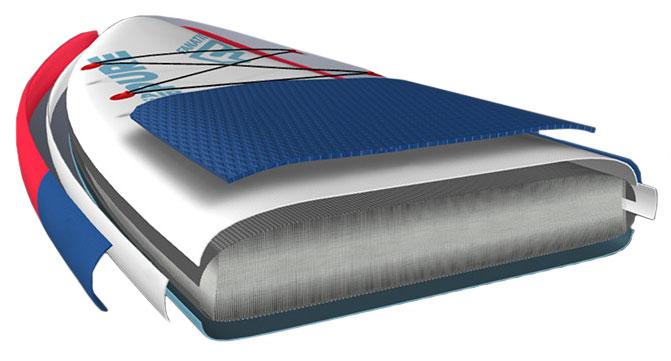
We kick things off with the Single Skin or Single Layer Technology. All of the construction methods start with the dropstitch; thousands of internal threads between the two dropstitch layers which when filled with air allow the board to only expand to a certain point before they pull tight and form the rigid SUP's shape. Dropstitch fabric on its own isn't airtight, so then a liquid PVC layer covers the dropstsitch which, once dry, creates an airtight seal. This is the single skin.
The two main advantages of the single skin boards are weight and price. Less material makes for a very lightweight SUP and someone working on a tight budget, this construction has a slight lower max weight than the stringer or laminated versions. With boards using this construction from the decent brands starting at £449, they're great value. On the down-side, they're not going to be quite as durable or offer such an authentic paddling experience as the other constructions due to having fewer layers and a little more flex in the board.
+ Lightweight + Low Price - Flex
Stringer Construction
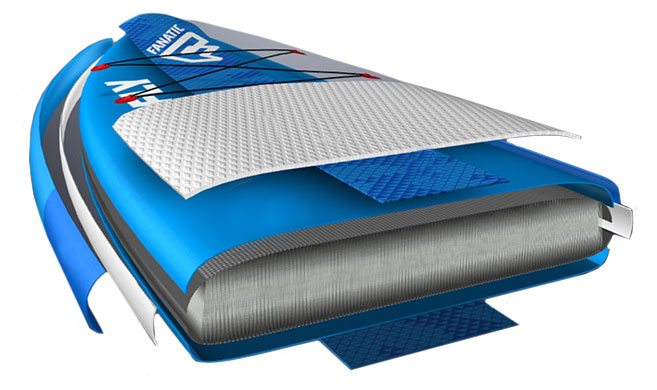
Following on from the single layer construction we have boards that introduce Stringer Technology. The majority of the paddleboard is the same as the single layer; dropstitch with a single coating of PVC. The difference is the addition of the 'stringer'. The concept comes from traditional surfboard manufacture, where a thin 'stringer' runs down the centre of the board from nose to tail to provide increased rigidity. On these inflatable SUPs the stringer is a fairly wide PVC strip glured down the centre of the board.
The addition of the stringer is all about increasing the rigidity of the SUP in turn reducing flex as you stand on the board and paddle. The extra bit of material creates a more solid platform, that in turn makes for a better paddling experience. As it's only a small addition of material it doesn't add that much weight, and the costs for these SUPs are still good. The downsides? Well although the stringer is a good addition it won't change your entire world. They still don't offer as much rigidity as the following full double layer construction below.
+ Increased Stiffness + Still Low Price - Still Some Flex
Fusion Double Layer Construction
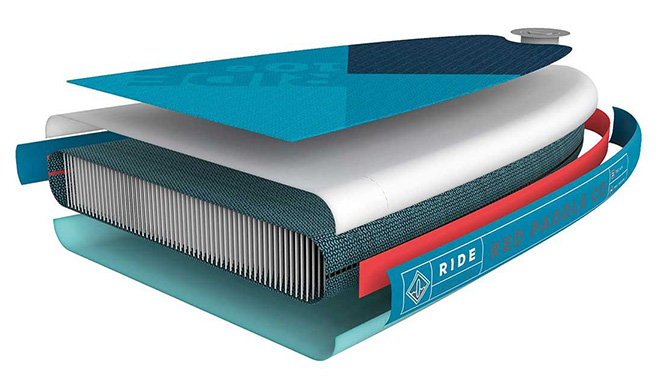
The laminated double layer construction is the premium standard technology in inflatable SUP manufacturing process.
The lamination process means that there are no longer cosmetic wrinkles or bubbles on the board's surface. And here's the really impressive bit... these inflatable SUPs are 20-25% lighter and 25-30% stiffer than those using a glued double layer construction. That can mean around a 2kg saving in weight, which is a lot! These SUPs can come out more expensive than the other constructions but we can offer this construction from £380, if you are looking for the best performance then we'd suggest you go for a laminated double layer board every time.
+ Stiffer + Durable + Stronger + Maintains Shape + Lightweight - Can be more expensive
Woven Fusion Double Layer Construction
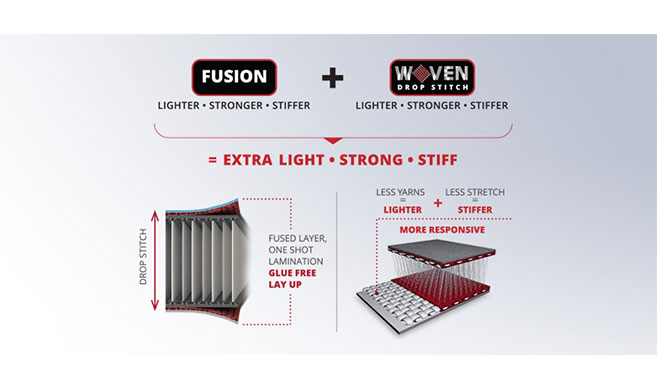
The Weave Fusion double layer construction is the premium technology in the inflatable SUP manufacturing process that was introduced about 3 years ago, with Gladiator been the first to recognise this new stiffer lighter material and Starboard coming 2nd, Red Paddle Co also use this material as a single skin version in their compact boards.
The Woven process means that the board is even lighter and stiffer, and admittedly this is stiff and light in comparison to the already stiff and light material of fusion double laminated, This new material really comes into its own for riders that are portaging a lot on the river and canal settings or riders that struggle carrying things heavy, this may be a shorter lighter rider or a rider with back concerns.
+ Stiffer + Durable + Stronger + Maintains Shape + Lightweight - Can be more expensive
Glued Double Layer Construction
Glued double layer construction is now only reserved now for boards that need to be super strong (river / rapid) or cheeper brands using outdated technology. A glued double layer construction starts with the single layer board; dropstitch covered in an initial PVC layer. From there, a second layer of PVC is glued to the board (not laminated). This differs to the stringer technology as it is a full coating over the whole board, not just a strip down the centre. It is also usual to have an extra layer around the rails of the board.
The extra PVC layer helps to increase the strength of the board. On the down-side the extra material makes these iSUPs heavier. The biggest brands like Red Paddle Co, Fanatic and Starboard, Gladiator Shark and Anomy have phased this technology out in all but specialist boards, replacing it with a 'laminated double layer construction or Woven technology', so this construction method is a little out-of-date.
+ Durable - Heavier - Outdated technology
Rail / Side wall Construction

Just a quick bit of information on sidewalls / rails of a SUP board, now you know about what’s on the top and bottom of a Paddle Board we thought its best to tell what holds it together
Sidewalls on Paddleboards can again vary in quality from brand to brand, but it's one of the most important parts of the construction, and something we pay close attention to. RED Paddle Co and Gladiator Pro and Elite both offer a premium triple rail edge sidewall construction as both brands bring the top and bottom layers around to meet and glue them together, then apply a 1.5” strip to seal that and then another 2.5” strip over that to give a triple layer rail. Fanatic premium and Shark also offer a triple rail edge by adding a strip to the top and bottom of the board rails offering durability right on the corners. Starboard offers a heat seal on their deluxe and takhine rangers and then applies a PVC layer over the top for aesthetics. All the other brands have a solid double-layer rail constructed, bringing the top and bottom layers to within 3/4” of each other, using a 2” strip to seal that board and a 3” strip to add strength.
One thing to strongly avoid is a board that has thin sidewalls, this normally shows a lack of understanding of the forces put on a rail of the board and creates a weakness both in terms of rail failure due to low quality gluing, these types of rails are normally identified easily as they feel thin and the top and bottom sheet are only just past the end edge of the board leaving 4"+ to be exposed with 1 layer holding them together. Brands will often rate their products 15psi are lower with this construction, knowing that the board will not be able to withstand the higher pressure and will have a seam failure (pop).
